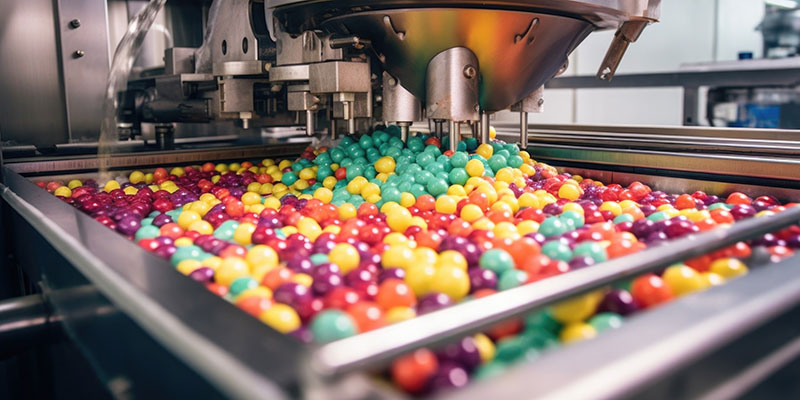The confectionary industry is just one of many that can benefit from EFC anaerobic digestion treatment for high-COD wastewater.
Fluence’s EFC reactor boosts anaerobic digestion to efficiently deal with high flows and high organic load.
Industrial operations are often charged high rates for municipal infrastructure to treat their high-strength wastewater. Pretreating effluent in-house with anaerobic digestion systems can reduce surcharges and provide an excellent ROI. For example, the confectionary industry produces wastewater with high COD from sugars, suspended solids, fats, oils, and grease, which can be a challenge for typical wastewater treatment solutions. Fluence’s external forced circulation (EFC) reactor is a game-changer.
The EFC reactor, designed and developed exclusively by Fluence, is a high-rate anaerobic system that increases digestion efficiency with lower hydraulic retention times than standard digesters.
Conventional and UASB digester design can be limited by the volume of flow and solids retention time. EFC picks up where the UASB reactor leaves off, improving its treatment of wastewater by adding a specially designed solids separation and recirculation system to maintain an effective granular sludge biomass.
The constant collection and recirculation of granular sludge maximizes the contact between the biomass and wastewater, enhancing overall system performance. The result is markedly higher efficiency and lower hydraulic retention times. HRT is typically less than two days, with many systems operating with less than one day of HRT.
Enhanced Purification
Other treatment methods often fall short when confronted with the highly soluble COD that characterizes confectionary effluent. The EFC reactor accelerates sugar and organic digestion, achieving purification levels above 85% with a fraction of the footprint. The technology is also a good fit for breweries, fruit processing plants, pulp and paper operations, and other processes that produce wastewater with a high organic load and lower solids concentrations.
Higher Energy Recovery
Wastewater from confectionary manufacturing operations is ideal for anaerobic digestion, containing much more energy than the amount needed to power the treatment plant in most cases.
The EFC reactor has other advantages over the UASB reactor, including higher efficiency in biogas production for waste-to-energy (WtE) systems. This biogas can be used to generate electricity and heat, which can be sold on established markets or can be used on-site to power operations, even the wastewater treatment process itself, with energy to spare.
Less Sludge Disposal
The EFC reactor produces less sludge than the UASB reactor, reducing the volume of waste that needs to be disposed of for an increase in sustainability. Recirculation of granular sludge biomass also helps to maintain process stability, which can reduce OPEX. The EFC reactor produces effluent with TSS levels well below 300 ppm in most cases. Sludge wasting is also minimized due to the retention of granular biomasses.
Smaller Physical Footprint
One design challenge for wastewater treatment systems in the confectionary industry is space management. Such plants are often established where additional land for construction comes at a premium or is not available at all.
Fluence engineers produce customized plant designs that allow for enhanced treatment with a smaller footprint based on the client’s needs.
For instance, Italcanditi-Vitalfood, a candy manufacturer in a small Italian city, was working with little available space and a 16-hour-a-day, six-day-a-week production cycle that could not be interrupted. Fluence upgraded the plant’s wastewater system with a custom design, featuring an EFC reactor that was easily installed in limited space due to its simple design and lack of sensitivity to disturbances. Like many Fluence food and beverage industry projects around the world, the installation was completed without a break in production.
Environmental Sustainability
Biogas production through anaerobic digestion is a productive form of resource recovery in terms of recovered value and environmental sustainability. While biogas contains carbon, it is considered a carbon-neutral fuel because the waste that produces it would have broken down and released carbon into the atmosphere anyway. When recovered, every unit of biogas used for energy represents a unit of fossil fuel that doesn’t have to be burned, for a dramatic net carbon savings.
In our age of climate change, another important resource recoverable from wastewater is the water itself. With additional Fluence treatment processes, an anaerobic digestion system enhanced with the EFC reactor produces an effluent that can be reused in boilers, washing, irrigation, toilet flushing, and an endless list of nonpotable applications.
Where there is enough high-strength effluent to support a reactor, anaerobic digestion produces a stream of free, carbon-neutral fuel while cleaning water, protecting the environment from contamination, and delivering climate resilience. It’s just the kind of advantage that affects cost-efficiency and boosts sustainability while attracting the attention of ESG investors.
The EFC advantage can help you prepare for Infrastructure Law incentives in the United States, as well as mature biogas markets and 2050 carbon-neutrality targets in the European Union.
Contact Fluence to explore an anaerobic digestion system with the EFC advantage for your unique high-strength wastewater.

